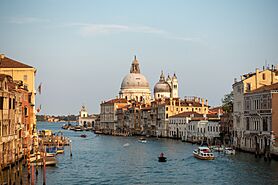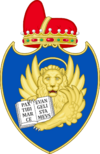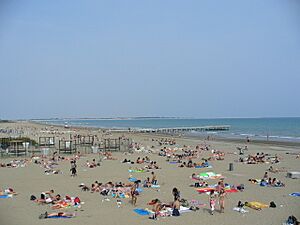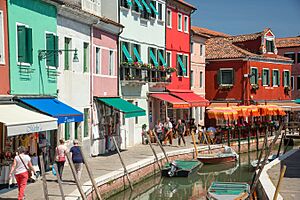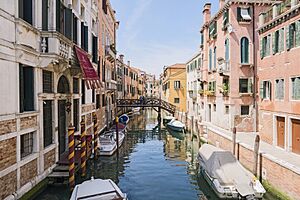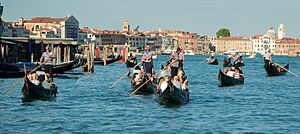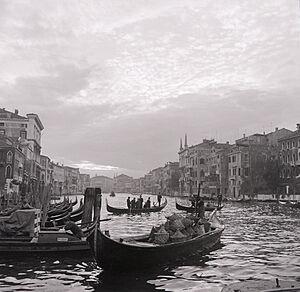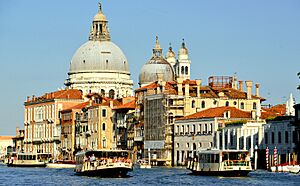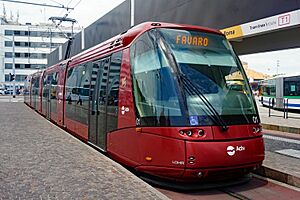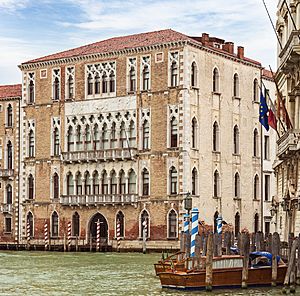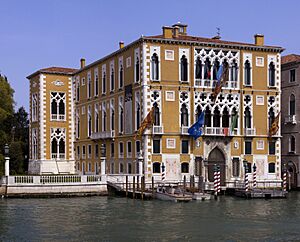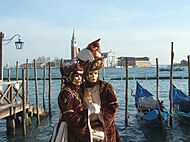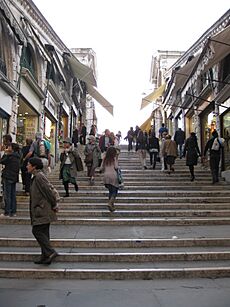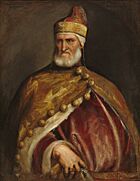Venice facts for kids
Quick facts for kids
Venice
|
|||
|---|---|---|---|
| Comune di Venezia | |||
|
|
|||
|
|||
| Country | Italy | ||
| Region | Veneto | ||
| Frazioni | Chirignago, Favaro Veneto, Mestre, Marghera, Murano, Burano, Giudecca, Lido, Zelarino | ||
| Area | |||
| • Total | 414.57 km2 (160.07 sq mi) | ||
| Elevation | 1 m (3 ft) | ||
| Population
(2020)
|
|||
| • Total | 258,685 | ||
| • Density | 623.984/km2 (1,616.111/sq mi) | ||
| Demonym(s) | Veneziano Venetian (English) |
||
| Time zone | UTC+1 (CET) | ||
| • Summer (DST) | UTC+2 (CEST) | ||
| Postal code |
30100
|
||
| Dialing code | 041 | ||
| Patron saint | St. Mark the Evangelist | ||
| Saint day | 25 April | ||
| UNESCO World Heritage Site | |
|---|---|
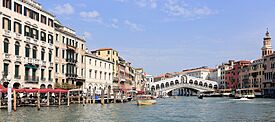
Venice in autumn, with the Rialto Bridge in the background
|
|
| Criteria | Cultural: i, ii, iii, iv, v, vi |
| Inscription | 1987 (11th Session) |
Venice (called Venezia in Italian) is a famous city in northeastern Italy. It is the capital of the Veneto region. Venice is built on 126 islands, separated by water and connected by 472 bridges. These islands are in the shallow Venetian Lagoon, a bay between the Po and Piave rivers. In 2020, about 258,685 people lived in Venice. Around 51,000 live in the historic island city. The rest live on the mainland. Venice is part of a larger metropolitan area with Padua and Treviso, home to 2.6 million people.
The city's name comes from the ancient Veneti people. They lived in this area around 1000 BC. Venice was the capital of the Republic of Venice for nearly 1,000 years (810 to 1797). It was a powerful trading city during the Middle Ages and Renaissance. Venice was important for trade in silk, grain, and spices. It was also a big center for art. Many historians say Venice was the first true international financial center. This made Venice very rich for most of its history. The city controlled many lands along the Adriatic Sea. Its buildings and culture still show this history today. The Venetian Arsenal, a huge shipyard, was key to Venice's naval power. Napoleon ended Venice's independence in 1797. Later, in 1866, Venice became part of the Kingdom of Italy.
Venice has many nicknames, like "City of Water" and "The Floating City." The historic parts of the city and its lagoon became a UNESCO World Heritage Site in 1987. Venice is famous for its beautiful setting, amazing architecture, and artwork. It was important for art movements, especially during the Italian Renaissance. It also played a big role in music. Famous Baroque composers like Tomaso Albinoni and Antonio Vivaldi were born here.
Today, Venice is a very popular place for tourists. It is a major cultural center. Many people call it one of the most beautiful cities in the world. However, Venice faces challenges. These include too many tourists, pollution, and high tides. Large cruise ships sailing too close to buildings are also a problem. UNESCO keeps a close eye on Venice. This is because its lagoon and cultural heritage are always at risk.
Contents
Discovering Venice's Past
How Venice Began
Historians believe Venice was founded by people escaping invaders. These refugees came from nearby Roman cities like Padua and Aquileia. They fled from attacks by Germanic tribes and Huns. Some old Roman writings mention "lagoon dwellers" who were fishermen. The traditional founding date is March 25, 421 AD. This is when the first church, San Giacomo on the Rialto islet, was dedicated.
In the 5th century, invaders like the Visigoths and Huns attacked the Italian peninsula. The Lombards arrived in 568. This left Venice as a small, isolated outpost of the Eastern Roman Empire. The city became more independent over time. New ports were built in the Venetian lagoon.
The first leader of Venice, called a "doge," was Paolo Lucio Anafesto. He was elected in 697. The word doge means "leader" in the Venetian language. It is like the English word "duke." In 751, the Lombards conquered much of the area. Venice became even more separate from the Byzantine Empire. The doge's home moved to the safer Rialto area. Here, the first ducal palace and St Mark's Basilica were built.
Charlemagne tried to take control of Venice. His son, Pepin, attacked the city. But the siege failed after six months. Pepin's army suffered from diseases in the swamps. In 814, an agreement recognized Venice as Byzantine land. It also gave the city important trading rights.
In 828, Venice gained more importance. It acquired relics believed to be from St Mark the Evangelist. These were placed in the new basilica. The winged lion, a symbol of St Mark, became Venice's emblem. As the Byzantine Empire weakened, Venice became truly independent.
Venice Grows into a Powerful Empire
From the 9th to the 12th centuries, Venice grew into a strong sea empire. It was one of the most important sea republics in Italy. Venice's location at the top of the Adriatic Sea made its navy and trade very secure. It cleared pirates from the Dalmatian coast. This made Venice a busy trade center between Europe and Asia. Its navy protected trade routes from pirates.
The Republic of Venice took control of many places on the eastern Adriatic coast. This was mainly for trade. The doge also became the Duke of Dalmatia and Istria. Later, Venice gained land on the mainland, called the Terraferma. This land helped protect the city from neighbors. It also ensured a supply of wheat. Venice controlled the salt trade. It also gained many islands in the Aegean Sea, like Crete and Cyprus. Venice became a major player in the Middle East.
Venice stayed close with Constantinople. It received special trading rights twice. This was in exchange for helping the Eastern Empire fight invaders. The second time, Venice did not show respect to the empire. This showed Venice's growing power and Byzantium's decline.
Venice became an imperial power after the Fourth Crusade in 1204. The crusaders attacked and looted Constantinople. Much of the treasure was brought back to Venice. This included the famous bronze horses from the Hippodrome. They were placed above the entrance to St Mark's Basilica. After Constantinople fell, Venice gained control of many areas in the Mediterranean.
By the late 13th century, Venice was the richest city in Europe. At its peak, it had 36,000 sailors and 3,300 ships. It controlled trade across the Mediterranean. Wealthy Venetian families built grand palaces. They also supported great artists. The city was ruled by the Great Council of Venice. This council was made up of noble families. They chose all public officials. They also elected a Senate. A smaller group, the Council of Ten, managed most of the city's daily business. One member of the Great Council was chosen as the "doge." He was the chief leader, usually for life.
Venice's government was like ancient Rome's republic. It had an elected leader (the doge) and a group of nobles. The people had limited political power. Venice was a republic throughout its history. Its leaders kept politics and the military separate. War was seen as a way to continue trade. So, Venice often hired soldiers from other countries.
Venetians were mostly Roman Catholic. But the state of Venice was known for its religious freedom. It did not execute anyone for religious beliefs. This often led to disagreements with the papacy. Venice was even banned by the Pope twice.
The printing press spread quickly in the 15th century. Venice quickly adopted this new technology. By 1482, Venice was the world's printing capital. Aldus Manutius was a leading printer. He invented paperback books. His "Aldine Editions" included translations of Greek writings.
Challenges and Changes
Venice's long decline began in the 15th century. It fought against the Ottoman Empire. These wars cost Venice many of its lands in the eastern Mediterranean. In 1497, Vasco da Gama found a sea route to India around Africa. This ended Venice's control over trade with the East. Venice's ships were not suited for ocean travel. So, Venice fell behind in the race for new colonies.
The Black Death hit Venice hard in 1348. It returned between 1575 and 1577, killing about 50,000 people. In 1630, another plague killed one-third of Venice's citizens.
Venice lost its role as a major international trade center. Portugal took over trade with the East. France and Spain fought for control of Italy. This reduced Venice's political power. However, Venice remained a big exporter of farm products. It was also an important manufacturing center until the mid-1700s.
Venice in Modern Times
The Republic of Venice lost its independence on May 12, 1797. Napoleon Bonaparte conquered the city during a war. Napoleon was seen as a liberator by the Jewish people. He removed the gates of the Venetian Ghetto. This ended rules about where Jews could live and travel.
Venice became Austrian territory in 1797. It was part of Napoleon's Kingdom of Italy from 1805 to 1814. Then it returned to Austria. In 1848, a revolt briefly brought back the Venetian republic. But it was crushed in 1849. In 1866, Venice became part of the new Kingdom of Italy.
During World War II, the historic city was mostly safe from attacks. Only one successful air strike targeted German naval operations in 1945. It destroyed targets without damaging the city's buildings. However, industrial areas nearby were bombed. On April 29, 1945, British and New Zealand troops freed Venice.
In 1987, Venice and its Lagoon were listed as a UNESCO World Heritage Site.
Venice's Unique Geography
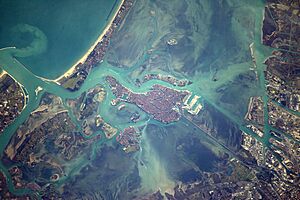
Venice is in northeastern Italy, in the Veneto region. It is built on 118 small islands. These islands are separated by canals and connected by 438 bridges. The historic center has six main areas called sestieri: Cannaregio, Castello, Dorsoduro, San Marco, San Polo, and Santa Croce.
Venice sits on silt carried by rivers from the Alps. This silt forms long banks, or lidi, shaped by sea currents.
Why Venice Sinks
Venice is slowly sinking. This, along with other things, causes seasonal "high water" or Acqua alta. During high tides, the lowest parts of the city can flood. Hundreds of years ago, Venetians changed rivers flowing into the lagoon. This made the lagoon deeper. It helped protect the city from land attacks. But it also made the city more prone to flooding. St Mark's Basilica, the lowest part of Venice, is only 64 centimeters above sea level.
In the 20th century, many wells were dug around the lagoon. These wells drew water for local industries. This caused Venice to sink faster. After these wells were banned in the 1960s, the sinking slowed down. But the city still faces frequent small floods. These floods cover the quays by several centimeters. In many old houses, the ground floors are now often flooded.
Studies show Venice is still sinking slowly, about 1-2 millimeters each year. So, the city remains on alert.
In 2003, Italy started the MOSE Project. This project aims to protect Venice from floods. It involves building 78 hollow gates on the seabed. These gates are at the three entrances to the lagoon. When high tides are expected, the gates fill with air and float up. This blocks water from the Adriatic Sea. The project was supposed to be finished by 2018. But it has faced delays and high costs.
On November 13, 2019, Venice had a major flood. Water levels reached 1.87 meters. This was the highest tide since 1966. More than 80% of the city was covered. Many cultural sites, including over 50 churches, were damaged. The mayor blamed the floods on climate change. Rising sea levels and the city's sinking make floods more common.
On October 3, 2020, the MOSE system was used for the first time. It successfully prevented flooding in low-lying areas like Piazza San Marco.
Venice's Weather
Venice has a humid subtropical climate. It has four seasons. Winters are cool and damp. Summers are warm and humid. The average temperature in January is 3.8°C (38.8°F). In July, it's 23.8°C (74.8°F). Rain falls fairly evenly throughout the year. Snow is rare but can happen from late November to early March. The canals can freeze in very cold winters. But this is less common now due to warmer temperatures.
| Climate data for Venice, elevation: 2 m or 6 ft 7 in, (1991–2020 normals, extremes 1961–present) | |||||||||||||
|---|---|---|---|---|---|---|---|---|---|---|---|---|---|
| Month | Jan | Feb | Mar | Apr | May | Jun | Jul | Aug | Sep | Oct | Nov | Dec | Year |
| Record high °C (°F) | 15.7 (60.3) |
22.0 (71.6) |
25.3 (77.5) |
27.2 (81.0) |
31.5 (88.7) |
35.2 (95.4) |
36.6 (97.9) |
36.5 (97.7) |
32.4 (90.3) |
27.3 (81.1) |
23.0 (73.4) |
16.7 (62.1) |
36.6 (97.9) |
| Mean daily maximum °C (°F) | 7.5 (45.5) |
9.2 (48.6) |
13.2 (55.8) |
17.4 (63.3) |
22.0 (71.6) |
26.0 (78.8) |
28.5 (83.3) |
28.4 (83.1) |
23.8 (74.8) |
18.5 (65.3) |
12.9 (55.2) |
8.3 (46.9) |
18.0 (64.4) |
| Daily mean °C (°F) | 3.8 (38.8) |
5.0 (41.0) |
8.9 (48.0) |
13.0 (55.4) |
17.7 (63.9) |
21.7 (71.1) |
23.8 (74.8) |
23.7 (74.7) |
19.3 (66.7) |
14.5 (58.1) |
9.3 (48.7) |
4.7 (40.5) |
13.8 (56.8) |
| Mean daily minimum °C (°F) | 0.1 (32.2) |
0.8 (33.4) |
4.5 (40.1) |
8.7 (47.7) |
13.5 (56.3) |
17.4 (63.3) |
19.2 (66.6) |
18.9 (66.0) |
14.8 (58.6) |
10.5 (50.9) |
5.7 (42.3) |
1.0 (33.8) |
9.6 (49.3) |
| Record low °C (°F) | −13.5 (7.7) |
−12.6 (9.3) |
−7.4 (18.7) |
−0.8 (30.6) |
2.0 (35.6) |
7.0 (44.6) |
10.2 (50.4) |
10.0 (50.0) |
5.0 (41.0) |
−1.1 (30.0) |
−8.8 (16.2) |
−12.5 (9.5) |
−13.5 (7.7) |
| Average precipitation mm (inches) | 40.2 (1.58) |
56.5 (2.22) |
60.5 (2.38) |
70.5 (2.78) |
80.2 (3.16) |
64.2 (2.53) |
57.9 (2.28) |
65.8 (2.59) |
73.3 (2.89) |
72.0 (2.83) |
71.5 (2.81) |
49.8 (1.96) |
762.4 (30.01) |
| Average precipitation days | 6.0 | 5.2 | 5.7 | 8.3 | 8.2 | 8.6 | 5.9 | 6.1 | 5.9 | 6.7 | 5.8 | 5.9 | 78.3 |
| Average relative humidity (%) | 81 | 77 | 75 | 75 | 73 | 74 | 71 | 72 | 75 | 77 | 79 | 81 | 76 |
| Mean monthly sunshine hours | 80.6 | 107.4 | 142.6 | 174.0 | 229.4 | 243.0 | 288.3 | 257.3 | 198.0 | 151.9 | 87.0 | 77.5 | 2,037 |
| Mean daily sunshine hours | 2.6 | 3.8 | 4.6 | 5.8 | 7.4 | 8.1 | 9.3 | 8.3 | 6.6 | 4.9 | 2.9 | 2.5 | 5.6 |
| Mean daily daylight hours | 9.2 | 10.4 | 12.0 | 13.6 | 14.9 | 15.6 | 15.3 | 14.1 | 12.5 | 10.9 | 9.5 | 8.8 | 12.2 |
| Percent possible sunshine | 29 | 38 | 38 | 41 | 49 | 51 | 62 | 59 | 51 | 45 | 29 | 28 | 43 |
| Average ultraviolet index | 1 | 2 | 3 | 5 | 7 | 8 | 8 | 7 | 5 | 3 | 2 | 1 | 4 |
| Source 1: Istituto Superiore per la Protezione e la Ricerca AmbientaleNOAA | |||||||||||||
| Source 2: MeteoAM (sun and humidity 1961–1990), Weather Atlas (daylight, UV) Temperature estreme in Toscana (extremes) | |||||||||||||
| Climate data for Venice (sea temperatures) | |||||||||||||
|---|---|---|---|---|---|---|---|---|---|---|---|---|---|
| Month | Jan | Feb | Mar | Apr | May | Jun | Jul | Aug | Sep | Oct | Nov | Dec | Year |
| Daily mean °C (°F) | 10.0 (50.0) |
8.8 (47.8) |
9.9 (49.8) |
13.4 (56.1) |
18.6 (65.5) |
23.4 (74.1) |
25.4 (77.7) |
25.4 (77.7) |
23.6 (74.5) |
19.3 (66.7) |
16.0 (60.8) |
13.3 (55.9) |
17.3 (63.0) |
| Source: Weather Atlas | |||||||||||||
People and Population
| Historical population | ||
|---|---|---|
| Year | Pop. | ±% |
| 1871 | 164,965 | — |
| 1881 | 165,802 | +0.5% |
| 1901 | 189,368 | +14.2% |
| 1911 | 208,463 | +10.1% |
| 1921 | 223,373 | +7.2% |
| 1931 | 250,327 | +12.1% |
| 1936 | 264,027 | +5.5% |
| 1951 | 310,034 | +17.4% |
| 1961 | 339,671 | +9.6% |
| 1971 | 354,475 | +4.4% |
| 1981 | 336,081 | −5.2% |
| 1991 | 298,532 | −11.2% |
| 2001 | 271,073 | −9.2% |
| 2011 | 261,362 | −3.6% |
| 2021 | 251,944 | −3.6% |
| Source: ISTAT | ||
Venice was one of Europe's largest cities in the Middle Ages. Its population reached 110,000–180,000 by 1300. In the mid-1500s, about 170,000 people lived there. By 1600, it was close to 200,000.
In 2021, Venice had 254,850 residents. About 50,434 lived in the historic city. The rest lived on the mainland or other islands. The population in the historic city has dropped. It went from about 120,000 in 1980 to 50,000 in 2021. Most residents (84.2%) are Italian. There are also large groups from Bangladesh, Romania, Moldova, China, and Ukraine.
Most people in Venice are Roman Catholic. There is also an Orthodox Christian community. Due to immigration, there is a large Muslim community. Some Hindu and Buddhist people also live there.
Venice has a historic Jewish community. The word "ghetto" comes from the Venetian word ghèto. This was the area where Jews had to live. The first full printed edition of the Talmud was made in Venice in 1523. Today, about 500 Jewish people live in Venice.
Venice's Economy
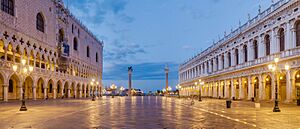

Venice's economy has changed a lot. In early times, it likely traded slaves. Its location helped it be a middleman in this trade. During the Middle Ages and Renaissance, Venice was a major trade center. It controlled a large sea empire. This made it a very rich European city. From the 11th to 15th centuries, Venice was a main starting point for trips to the Holy Land.
Armenian merchants were important traders in Venice. They specialized in gems and diamonds. By the 17th century, Venice's trade empire declined. Other countries like Portugal took over. Venice's importance as a naval power lessened. In the 18th century, it became a big exporter of farm and industrial goods. The Venice Arsenal was the largest industrial complex.
Today, Venice's economy relies on tourism, shipbuilding, and trade. Making Murano glass on Murano island is also very important. So is lace production on Burano island.
The city faces money problems. In 2016, it had a large budget deficit. Many locals are leaving the historic center. This is because rents are rising fast. The shrinking local population changes the city's character. Venice also faces erosion, pollution, and too many tourists. Large cruise ships sailing too close to buildings are another issue.
In 2017, Italy had to help two Venetian banks. This was to prevent them from going bankrupt. The government spent billions of euros to help.
Tourism in Venice
Venice is a huge tourist destination. People come to see its famous art and architecture. The city can host up to 60,000 tourists daily. Estimates say 22 to 30 million tourists visit each year. This "overtourism" causes overcrowding and environmental problems. By 2017, UNESCO thought about adding Venice to its "In-Danger" list. This list includes historical ruins in war zones. To help, UNESCO supports limiting cruise ships. It also wants more sustainable tourism.
Tourism has been key to Venice's economy since the 1700s. Back then, Venice was a stop on the "Grand Tour" for wealthy travelers. In the 1800s, it became a popular spot for the rich and famous. The Carnival of Venice was brought back in the 1980s. Venice now hosts major conferences and festivals. These include the Venice Biennale and the Venice Film Festival.
Today, Venice has many attractions. These include St Mark's Basilica, the Doge's Palace, and the Grand Canal. The Piazza San Marco is also very popular. The Lido di Venezia is a luxury destination. It attracts many actors and celebrities. The city also relies on the cruise ship business. However, day-trippers from cruise ships spend less money.
Some people see Venice as a "tourist trap." Others call it a "living museum."
Managing Cruise Ships
Protecting Venice's historic environment is important. The Italian Transport Ministry tried to ban large cruise ships. A 2013 ban would have stopped ships over 40,000 tons from entering the Giudecca Canal. In 2015, a court canceled the ban. But some cruise lines still avoided Venice.
In 2017, officials decided to keep the largest cruise ships away from Piazza San Marco. Ships over 55,000 tons must use a different canal. This route goes to Marghera, an industrial area. A new passenger terminal would be built there.
In 2014, the United Nations warned Venice. It might be put on UNESCO's "in danger" list. This would happen if cruise ships were not banned from the canals.
Activists want to reduce cruise ship numbers. They say up to 30,000 sightseers arrive daily. An unofficial vote in 2017 showed strong support for banning large ships. Most people wanted a new terminal outside the historic area. Passengers would then use smaller boats.
On June 2, 2019, a cruise ship hit a riverboat in the Giudecca Canal. This injured five people. It led to new calls for banning large ships. Italy's transport minister promised a solution. On August 7, 2019, Italy announced it would reroute ships over 1000 tons. They would dock at terminals away from the central islands. By 2020, one-third of all cruise ships would be rerouted. The Italian government decided to divert large cruise ships starting August 2021.
Other Efforts to Manage Tourism
Cruise ships can damage the city's foundations. They also cause pollution. Too many day-trippers can make St. Mark's Square very crowded. Officials say these tourists spend little money.
In mid-2017, Venice banned new hotels. There are already over 24,000 hotel rooms. The city also banned new fast-food places. This helps keep the city's historic feel. However, most visitors do not stay overnight.
The city considered banning wheeled suitcases. But it settled for banning hard plastic wheels for cargo in 2015.
On February 28, 2019, Venice voted for a new fee. Day-trippers visiting the historic center must pay it. This money will help clean the city and keep it safe. It also aims to reduce the burden on residents. The fee is €3 to €10 per person. Students, young children, and hotel guests are exempt. The fee started on April 25, 2024. It is only charged on busy days.
A new rule from June 1, 2024, limits tour groups to 25 people. It also bans loudspeakers.
Getting Around Venice
Transport in the Historic Center
Venice is built on 118 islands in a shallow lagoon. These islands are connected by 400 bridges over 177 canals. In the 1800s, a causeway brought the railroad to Venice. In the 1900s, a road causeway and parking areas were built. But within the historic center, transport is still by water or on foot. Venice is Europe's largest car-free area. It is unique for being a big city without cars or trucks.
The classic Venetian boat is the gondola. Today, gondolas are mostly for tourists. They are also used for special events like weddings or funerals. Traghetti are gondolas used as ferries to cross the Grand Canal. Two oarsmen operate them.
There are about 400 licensed gondoliers in Venice. Many gondolas have velvet seats and Persian rugs. Each gondola has a metal front piece called the fèro. Its shape has changed over time. It has six points for the city's six areas (sestieri). One point faces backward for the Giudecca island. A smaller, simpler boat is the sandolo.
Waterways of Venice
Venice's small islands were improved in the Middle Ages. Soil was dug up to raise the land above the tides. The canals created a strong boating culture. This was key to the city's economy. Today, these canals are still used to move goods and people.
The many canals need over 400 bridges for walking. In 2011, the Ponte della Costituzione opened. It is the fourth bridge over the Grand Canal. It connects the bus terminal to the railway station. The other bridges are the Ponte di Rialto, the Ponte dell'Accademia, and the Ponte degli Scalzi.
Public Transportation
The public transport company in Venice is called ACTV.
Lagoon Area Transport
The main public transport is by motorized waterbuses, called vaporetti. They run on regular routes along the Grand Canal. They also connect the city's islands. Private water taxis are also available. The traghetti are gondola ferries. They cross the Grand Canal where there are no bridges. Other gondolas are rented by tourists.
The Venice People Mover is an elevated train. It connects Tronchetto island (with parking) to Piazzale Roma. Piazzale Roma is where visitors arrive by bus or car. The train also stops at the Marittima cruise terminal.
Lido and Pellestrina Islands Transport
Lido and Pellestrina are islands that form a barrier. They separate the southern Venetian Lagoon from the Adriatic Sea. Cars and buses are allowed on these islands. Vaporetti connect them to other islands like Venice, Murano, and Burano.
Mainland Transport
The mainland part of Venice has four areas. Mestre is the largest and most populated. There are many bus routes and two tram lines. Several bus routes and one tram line connect the mainland to Piazzale Roma. This is the main bus station in Venice. They cross the Ponte della Libertà, the bridge to the historic center.
On a weekday, people in Venice spend about 52 minutes using public transit. Most riders wait about 10 minutes at a stop. The average distance traveled in one trip is 7 kilometers.
Rail Travel
Venice has regional and national train services. You can take trains to Florence, Milan, Rome, and Naples. There are also international trains to Zurich, Munich, and Vienna. Overnight sleeper trains go to Paris.
The Venezia Santa Lucia railway station is in the historic city. It's near a vaporetto stop and Piazzale Roma. This station is the end point for local trains. It also serves the luxury Venice Simplon Orient Express.
The Venezia Mestre railway station is on the mainland. Both stations are connected by the Ponte della Libertà.
Ports

The Port of Venice is Italy's eighth busiest commercial port. It was a major hub for cruise ships. However, since August 2021, ships over 25,000 tons cannot use the Giudecca Canal. The port is important for European trade networks. In 2006, over 30 million tons of goods passed through it. It also handled 1.4 million passengers.
Air Travel
The Marco Polo International Airport is named after Marco Polo. It is on the mainland. You can get to Venice's Piazzale Roma by bus or motorboat from the airport. Buses also go to Mestre and other regional cities.
Treviso Airport, about 30 kilometers from Venice, is used by low-cost airlines. Public buses connect it to Venice.
Venezia-Lido "Giovanni Nicelli" is a small airport. It is on the northeast end of Lido di Venezia. It has a grass runway for smaller planes.
Sports and Activities
The most famous Venetian sport is Voga alla Veneta. This is a special way of rowing. Rowers stand up and face forward. Today, gondoliers use this style. Many races, called regata(e), happen throughout the year. The biggest event is the "Regata Storica" in September.
Venice's main football club is Venezia F.C.. It was founded in 1907. They play in the Serie A. Their stadium, the Stadio Pier Luigi Penzo, is one of the oldest in Italy.
The local basketball club is Reyer Venezia. It was founded in 1872. The men's team won Italian championships in 1942, 1943, and 2017. Their arena is in Mestre. The club's president is also the mayor of Venice, Luigi Brugnaro.
Learning and Education
Venice is an important place for higher education. It has several universities:
- Ca' Foscari University of Venice, founded in 1868.
- Università Iuav di Venezia, founded in 1926.
- Venice International University, founded in 1995 on San Servolo island.
- European Inter-University Centre for Human Rights and Democratisation (EIUC) on Lido di Venezia.
Other important schools include:
- The Accademia di Belle Arti (Academy of Fine Arts), started in 1750.
- The Benedetto Marcello Conservatory of Music, a music school.
Venetian Culture
Literature and Writing
Venice has inspired many writers and poets. It was also a leader in printing and publishing.
Two famous Venetian writers were Marco Polo and Giacomo Casanova. Marco Polo (1254–1324) was a merchant. He traveled to the East. His book, Il Milione, shared important knowledge about lands from the Middle East to China. Giacomo Casanova (1725–1798) was an adventurer and writer. His autobiography, Histoire De Ma Vie, tells about his life in Venice.
Venetian playwrights used the old Italian theater style called commedia dell'arte. Writers like Carlo Goldoni used the Venetian dialect in their comedies.
Venice has also inspired foreign writers. Shakespeare set Othello and The Merchant of Venice in the city. Thomas Mann wrote his novel Death in Venice (1912) about the city. The German author Cornelia Funke set her children's book The Thief Lord in Venice.
The poet Ugo Foscolo (1778–1827) was born on an island that belonged to Venice. He wanted Venice to be a free republic. The poet Ezra Pound also wrote his first works in Venice. He is buried on Venice's cemetery island, San Michele.
Venice was also important for printing. The Aldine Press, founded by Aldus Manutius in 1494, was one of Italy's first printing presses. Venice became a major printing center. About 15% of all printing in the 15th century came from Venice.
Words from Venice
Some English words come from Venetian. These include: arsenal, ciao, ghetto, gondola, lagoon, lido, and regatta.
Printing History
By the end of the 1400s, Venice was Europe's printing capital. It had 417 printers by 1500. The Aldine Press was the most important. It printed the first work by Aristotle in 1497. It also printed Hypnerotomachia Poliphili, considered the most beautiful Renaissance book. This press helped create modern punctuation and page formats.
Painting Style
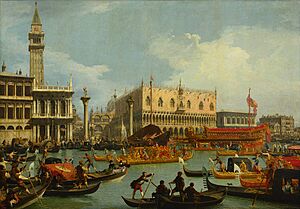
Venice was a major art center, especially during the Renaissance and Baroque periods. It developed a unique style called Venetian painting. Many wealthy Venetians supported artists. Venice was a rich trading republic.
In the 16th century, Venetian painting grew. It was influenced by artists like Antonello da Messina. He brought the oil painting technique to Venice. Venetian painting is known for its warm colors. Early masters included the Bellini and Vivarini families. Later came Giorgione, Titian, Tintoretto, and Veronese.
Canvas (the material paintings are made on) started in Venice during the early Renaissance. In the 18th century, Venetian painting had a comeback. This was with Giovanni Battista Tiepolo's decorative art. Also, Canaletto and Guardi created famous panoramic views of the city.
Venetian Architecture
Venice is built on soft mud-banks. Its city center was very crowded by the Middle Ages. But the city was safer from riots and invasions than most European cities. These factors, along with the canals and wealth, led to unique building styles.
Venice has many architectural styles. The most famous is the Gothic style. Venetian Gothic architecture mixes Gothic arches with curved "ogee" arches. This is due to influences from Byzantine and Ottoman styles. This style began in 14th-century Venice. Examples include the Doge's Palace and the Ca' d'Oro. The city also has many Renaissance and Baroque buildings. These include the Ca' Pesaro and the Ca' Rezzonico.
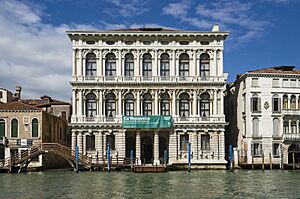
Venetian tastes were traditional. Renaissance architecture became popular only around the 1470s. It kept many features of Gothic palaces. This makes buildings from different periods look harmonious together.
Rococo Style
Venice created some of the best and most detailed Rococo designs. At this time, Venice's economy was declining. But it remained a fashion center. Venetian Rococo was known for being rich and luxurious. It often had very fancy designs. Unique Venetian furniture included long Rococo couches. Bedrooms of rich Venetians were grand. They had rich fabrics and carved beds with angels and flowers. Venice was famous for its mirrors. Chandeliers were colorful, made with Murano glass. Lacquer was common on furniture.
Glass Making
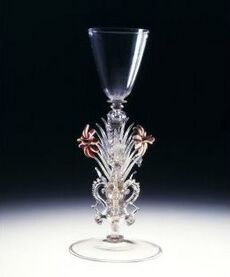
Venice is famous for its beautiful glasswork. This is known as Venetian glass. It is colorful, detailed, and skillfully made. Many features of this glass were developed by the 1200s. By the end of that century, glassmaking moved to Murano island. Glass made there is called Murano glass.
Byzantine artists helped develop Venetian glass. When Constantinople was attacked in 1204, some artists came to Venice. More arrived when the Ottomans took Constantinople in 1453. By the 1500s, Venetian artists could control the color and clearness of their glass. They also mastered many decorating techniques. Even though Venice tried to keep its glassmaking secrets, the techniques spread.
Some of the world's most important glass brands are still made on Murano. These include Venini and Barovier & Toso. Barovier & Toso is one of the oldest companies in the world, started in 1295.
In 2021, Venetian glass beads were found in Alaska. They were found at ancient Inuit sites. Researchers believe these beads traveled across Europe and Asia. Then they crossed the Bering Strait. This means they arrived in North America before Christopher Columbus.
Festivals and Celebrations
The Carnival of Venice is held every year. It lasts about two weeks and ends on Shrove Tuesday. People wear special Venetian masks.
The Venice Biennale is a major art event. It started in 1895 as an exhibition of Italian art. It was stopped during World War II but restarted in 1948.
The Festa del Redentore is in mid-July. It celebrates the end of the plague in 1576. A bridge of boats is built to connect Giudecca to Venice. Fireworks are a big part of the celebration.
The Venice Film Festival is the oldest film festival in the world. It started in 1932. It takes place every year in late August or early September on the Lido island. It is one of the most respected film festivals.
Music in Venice

Venice has played a big role in Italian music. The Venetian state was often called the "Republic of Music." A French person in the 1600s said, "In every home, someone is playing a musical instrument or singing. There is music everywhere."
In the 16th century, Venice became a top music center in Europe. It had a special style of music called the Venetian school. Composers like Adrian Willaert worked at St Mark's Basilica. Venice was also an early center for printing music. This attracted composers from all over Europe. By the end of the century, Venice was known for its grand music. Composers like Andrea Gabrieli and Giovanni Gabrieli used many choirs and instruments. Venice was also home to many famous Baroque composers. These include Antonio Vivaldi and Tomaso Albinoni.
Orchestras in Venice
Venice has many orchestras. Some are the Orchestra della Fenice, Rondò Veneziano, and Venice Baroque Orchestra.
Photography
Fulvio Roiter was a pioneer in artistic photography in Venice. Many photographers followed him. Their works are often seen on postcards. Luca Zordan, a New York City photographer, was born in Venice.
Venetian Food
Venetian food often includes seafood. It also uses garden products from the lagoon islands. Rice from the mainland, game, and polenta are also common. Venice's food mixes local traditions with influences from distant countries.
Some famous dishes are:
- Sarde in saór (marinated sardines).
- Bacalà mantecato (a dish with stockfish and olive oil).
- Risòto col néro de sépe (risotto with cuttlefish ink).
- Cichéti (small, tasty snacks like tapas).
- Prosecco, a bubbly, slightly sweet wine.
Venice is also known for its sweets. These include:
- Baìcoli (golden, oval cookies).
- Cookies with almonds and pistachios.
- Bussolài (ring-shaped or S-shaped cookies from Burano island).
- Galàni or cróstoli (fried pastries).
- Frìtole (fried doughnuts).
- Fregolòtta (a crumbly almond cake).
- Rosàda (a milk pudding).
- Zaléti (cookies made with yellow corn flour).
The dessert tiramisù is thought to have been created in Treviso in the 1970s. It is popular in the Veneto area.
Fashion and Shopping
In the 14th century, young Venetian men wore tight, colorful pants. Their designs showed which "Trouser Club" they belonged to. The Venetian Senate passed laws about clothing. But people just changed fashions to get around the rules.
Today, Venice is a major fashion and shopping center. It is not as big as Milan or Rome. But it is similar to Verona and Turin. Roberta di Camerino is the only major Italian fashion brand based in Venice. It was founded in 1945. It is known for its creative handbags. These are made by Venetian artists and often covered in local velvet.
International Connections
Sister Cities
Venice is twinned with these cities:
- Dubrovnik, Croatia
- Istanbul, Turkey
- Palembang, Indonesia
- Saint Petersburg, Russia
- Sarajevo, Bosnia and Herzegovina
- Suzhou, China
- Tallinn, Estonia
- Yerevan, Armenia
- Odesa, Ukraine
- Aksaray, Turkey
In 2013, Venice wanted to end its sister city link with St. Petersburg. This was because of Russia's laws against homosexuals.
Cooperation Agreements
In 2000, Venice and Greek cities created the Marco Polo System. This group promotes European cultural and tourist projects. It focuses on saving art and buildings.
In 2001, Venice signed an agreement with Italy's Foreign Affairs Ministry. This was to help promote Italian culture abroad.
Venice also has agreements with:
- Lübeck, Germany (1979)
- Nuremberg, Germany (1999)
- Qingdao, China (2001, for science and technology)
- Thessaloniki, Greece (2003)
- Miami, United States (2020)
Places Named After Venice
The name "Venezuela" means "Little Venice" in Spanish. Many other places around the world are named after Venice, such as:
- Venice, Los Angeles, California, USA
- Venice, Alberta, Canada
- Venice, Florida, USA
- Venice, New York, USA
- Venice, Louisiana, USA
- Little Venice, London, UK
Famous People from Venice
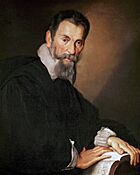
Music
- Andrea Gabrieli (c. 1510–1586), composer and organist.
- Giovanni Gabrieli (1554/1557–1612), composer and organist.
- Claudio Monteverdi (1567–1643), composer and choirmaster.
- Francesco Cavalli (1602–1676), a Baroque composer.
- Tomaso Albinoni (1671–1751), a Baroque composer.
- Antonio Vivaldi (1678–1741), famous Baroque composer and violinist.
- Domenico Montagnana (1686–1750), a master violin and cello maker.
- Pietro Guarneri (1695–1762), a violin maker.
- Lorenzo Da Ponte (1749–1838), opera writer for Wolfgang Amadeus Mozart.
- Domenico Dragonetti (1763–1846), a double bass player and composer.
- Ermanno Wolf-Ferrari (1876–1948), Italian composer of comic operas.
- Luigi Nono (1924–1990), a leading modern composer.
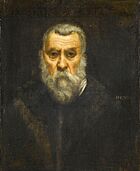
Painting
- Giovanni Bellini (c. 1430–1516), Renaissance painter.
- Vittore Carpaccio (c. 1465–1525/1526), Italian painter.
- Titian (c. 1488/90–1576), leader of the Venetian Renaissance painters.
- Tintoretto (1518–1594), a great Italian Renaissance painter.
- Rosalba Carriera (1675–1757), Rococo painter known for pastels.
- Giovanni Battista Tiepolo (1696–1770), Rococo painter.
- Canaletto (1697–1768), painter famous for Venice landscapes.
- Pietro Longhi (c. 1702–1785), painter of daily life scenes.
Writing
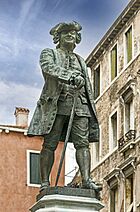
- Marco Polo (c. 1254–1324), trader and explorer.
- Aldus Manutius (1449–1515), important printer.
- Paolo Sarpi (1552–1623), historian and statesman.
- Carlo Goldoni (1707–1793), famous playwright.
- Carlo Gozzi (1720–1806), playwright.
Leaders and Public Servants
- Enrico Dandolo (c. 1107–1205), Doge of Venice.
- Pope Eugene IV (1383–1447), Pope.
- Pope Paul II (1417–1471), Pope.
- Andrea Gritti (1455–1538), Doge of Venice.
- Pietro Bembo (1470–1547), scholar and cardinal.
- Elena Lucrezia Cornaro Piscopia (1646–1684), the first woman in the world to get a doctorate degree.
- Daniele Manin (1804–1857), Italian patriot and leader.

Explorers
- Marco Polo (c. 1254–1324), famous explorer of the Silk Road.
- Sebastian Cabot (c. 1484–1557), explorer.
Architects
- Leon Battista Alberti (1404–1472), architect and humanist.
- Baldassare Longhena (1598–1682), Baroque architect.
- Carlo Scarpa (1906–1978), modern architect.
Entertainers
- Marietta Zanfretta (1837–1898), high-wire dancer.
- Romano Scarpa (1927–2005), creator of Disney comics.
Sports Figures
- Ercole Olgeni (1883–1947), Olympic rower.
- Dominic DeNucci (1932–2021), professional wrestler.
- Ivano Bordon (born 1951), former football goalkeeper.
- Mauro Numa (born 1961), Olympic fencer.
- Andrea Borella (born 1961), Olympic fencer.
- Dorina Vaccaroni (born 1963), Olympic fencer.
- Daniele Scarpa (born 1964), Olympic sprint canoer.
- Carolina Morace (born 1964), former female footballer.
- Tommaso Rocchi (born 1977), former footballer.
- Giovanni Paramithiotti, founder of Inter Milan football club.
See also
 In Spanish: Venecia para niños
In Spanish: Venecia para niños


